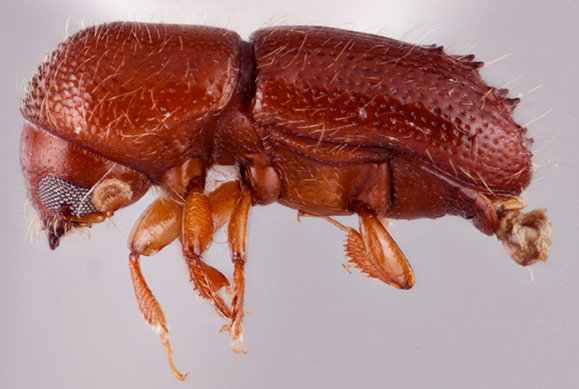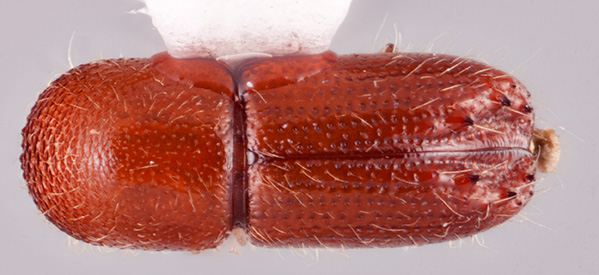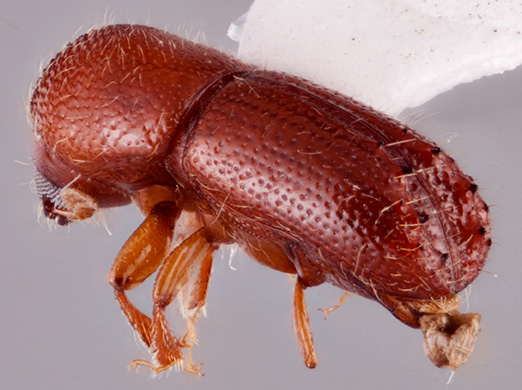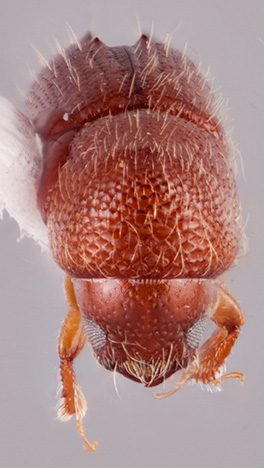Ambrosiophilus sexdentatus
|
Ambrosiophilus sexdentatus lateral; R.K. Osborn |
|
Ambrosiophilus sexdentatus dorsal; R.K. Osborn |
|
Ambrosiophilus sexdentatus declivity; R.K. Osborn |
|
Ambrosiophilus sexdentatus frontal; R.K. Osborn |
Taxonomic history
Xyleborus sexdentatus Eggers, 1940: 148.
Ambrosiodmus sexdentatus (Eggers): Wood and Bright, 1992: 680.
Ambrosiophilus sexdentatus (Eggers): Hulcr and Cognato, 2009: 24.
Diagnosis
2.7−3.0 mm long (mean = 2.84 mm; n = 5); 2.7−2.9 times as long as wide. This species can be distinguished by declivitaldeclivital:
pertaining to the elytral declivity
interstriae 1, 2, 3 each armed by one major tubercletubercle:
a small knob-like or rounded protuberance of the exoskeleton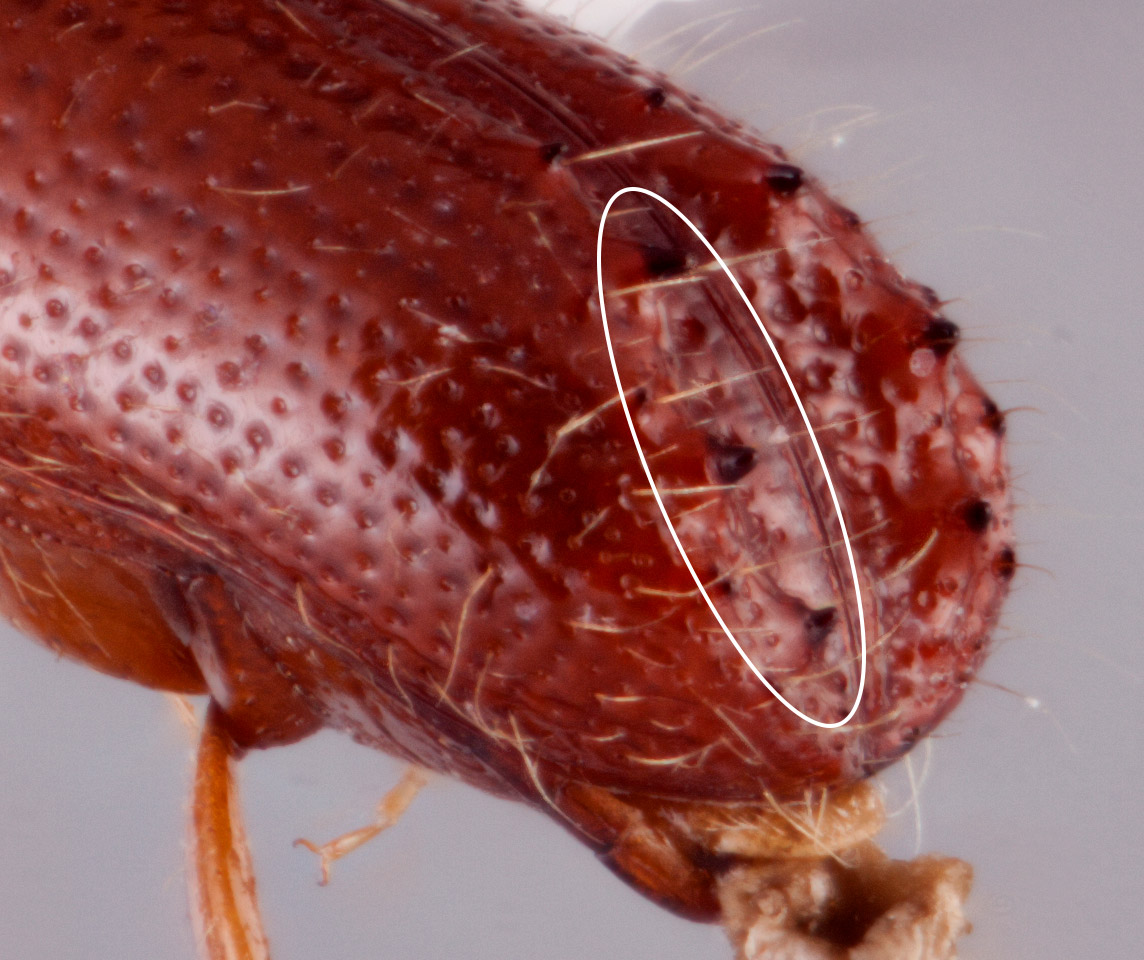 surrounding declivitaldeclivital:
surrounding declivitaldeclivital:
pertaining to the elytral declivity
sulcus; pronotumpronotum:
the dorsal surface of the thorax
from dorsaldorsal:
of or relating to the upper surface; opposite of ventral
 view basic (type 2); pronotalpronotal:
view basic (type 2); pronotalpronotal:
pertaining to the pronotum
declivitydeclivity:
downward slope of either the pronotum or elytra
 rounded, convexconvex:
rounded, convexconvex:
appearing rounded ; pronotumpronotum:
; pronotumpronotum:
the dorsal surface of the thorax
anterioranterior:
the front or forward; opposite of posterior margin lacking serrations; pronotumpronotum:
margin lacking serrations; pronotumpronotum:
the dorsal surface of the thorax
from laterallateral:
pertaining to the side
 view tall (type 2); pronotalpronotal:
view tall (type 2); pronotalpronotal:
pertaining to the pronotum
discaldiscal:
pertaining to the disc of either the pronotum or elytra
punctures small, fine spaced by at least two diameters of a puncture, surface shiningshining:
appearing glossy or bright in luster; referring to a surface that is polished and reflects light well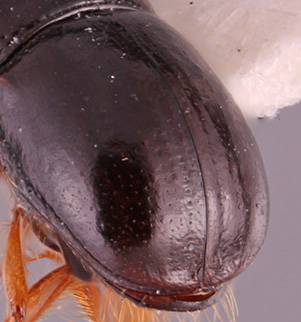 ; elytralelytral:
; elytralelytral:
pertaining to the elytra
declivitydeclivity:
downward slope of either the pronotum or elytra
 strongly sulcatesulcate:
strongly sulcatesulcate:
deeply furrowed or grooved
to interstriaeinterstria:
longitudinal spaces along the elytra between the striae, which is not as<br />
impressed and bear smaller punctures.
 3, laterallateral:
3, laterallateral:
pertaining to the side
 margins of sulcussulcus:
margins of sulcussulcus:
a groove or furrow
rounded, margin armed with three large spinesspine:
an elongate projection of the exoskeleton that is longer than its basal width , one at the basebase:
, one at the basebase:
point or edge closest to the body; opposite of apex of interstriaeinterstria:
of interstriaeinterstria:
longitudinal spaces along the elytra between the striae, which is not as<br />
impressed and bear smaller punctures.
 2, one at the declivitaldeclivital:
2, one at the declivitaldeclivital:
pertaining to the elytral declivity
midpoint of interstriaeinterstria:
longitudinal spaces along the elytra between the striae, which is not as<br />
impressed and bear smaller punctures.
 3 and one on the apicalapex:
3 and one on the apicalapex:
point or edge furthest from the body; opposite of base
 third of interstriaeinterstria:
third of interstriaeinterstria:
longitudinal spaces along the elytra between the striae, which is not as<br />
impressed and bear smaller punctures.
 3.
3.
May be confused with
Ambrosiophilus latisulcatus and A. sulcatus
Distribution
Indonesia (Java), Papua New Guinea, Thailand
Host plants
recorded from Quercus (Fagaceae) and Tectona (Lamiaceae) in Java (Kalshoven 1959bKalshoven 1959b:
Kalshoven LGE. 1959b. Studies on the biology of Indonesian Scolytoidea 4. Data on the habits of Scolytidae. Second part. Tijdschrift voor Entomologie 102: 135-173 + pls. 15-22.)
Remarks
a mycocleptic associate of Beaverium species (Hulcr and Cognato 2010bHulcr and Cognato 2010b:
Hulcr J, Cognato AI. 2010b. Repeated evolution of theft in fungus farming ambrosia beetles. Evolution 64: 3205-3212. https://doi.org/10.1111/j.1558-5646.2010.01055.x, Hulcr and Cognato 2013Hulcr and Cognato 2013:
Hulcr J, Cognato AI. 2013. Xyleborini of New Guinea: a taxonomic monograph. Thomas Say Publications in Entomology, Entomological Society of America, Lanham, Maryland, 176 pp.)
DNA data
Sequences available for COI and CAD.
COI: HM064051.1
CAD: HM064230.1

